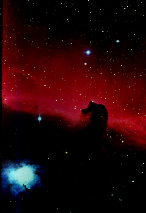Nebulae
Practically all of the objects we see with our naked eyes
in the night sky are stars. However,
there are lots of objects out there visible through a small telescope or
binoculars which are not stars. Many are called by the generic term
"nebula." Some of these nebulae are the clouds of gas and dust which
will collapse and form stars. Others are the results of a star's explosion
at the end of it's life.
The most prominent gaseous nebula in the sky is the Orion Nebula (M42/NGC
1976).
The three bright stars here
make the belt of Orion. It is just below these three stars that the
Orion Nebula lies. Here's a photograph.
 The Orion Nebula is about 1700 light years away and the size as seen here
is about 30 light years. Although the density of the material is less than
the best laboratory vacuum created on the Earth, the total mass in the
nebula is large enough to make 10,000 stars the size of the Sun. The light
is generated in a way similar to a flourescent lamp. The gas (which is
mostly hydrogen, helium, carbon, oxygen and nitrogen) is excited by a
collection of stars in the nebula called Theta Orionis. These stars formed
from gases of the nebula about 23,000 years ago (making them VERY young
stars). In fact, stars are still forming in this "stellar nursery." It
is in an environment such as this that all stars formed.
The Orion Nebula is about 1700 light years away and the size as seen here
is about 30 light years. Although the density of the material is less than
the best laboratory vacuum created on the Earth, the total mass in the
nebula is large enough to make 10,000 stars the size of the Sun. The light
is generated in a way similar to a flourescent lamp. The gas (which is
mostly hydrogen, helium, carbon, oxygen and nitrogen) is excited by a
collection of stars in the nebula called Theta Orionis. These stars formed
from gases of the nebula about 23,000 years ago (making them VERY young
stars). In fact, stars are still forming in this "stellar nursery." It
is in an environment such as this that all stars formed.
In the same neighborhood of the sky as the Orion Nebula is the Horsehead
Nebula (B33, IC 434). It is just below this star which is called Zeta Orionis. Here's a
picture.
 Unfortunately, this object is nearly invisible to the eye, even
through a large telescope, but can be seen in long exposure photographs.
The
shape you see is the result of a great obscuring mass of gas and dust in
front of a bright region of nebulosity. The illuminated area is about 18
light years in extent and the distance is about 1200 light years away.
Under proper conditions, we might expect this material to condense into
stars, but that is not the case presently.
Unfortunately, this object is nearly invisible to the eye, even
through a large telescope, but can be seen in long exposure photographs.
The
shape you see is the result of a great obscuring mass of gas and dust in
front of a bright region of nebulosity. The illuminated area is about 18
light years in extent and the distance is about 1200 light years away.
Under proper conditions, we might expect this material to condense into
stars, but that is not the case presently.
Go to next section.
Return to
"Planetarium Shows This Semester"


